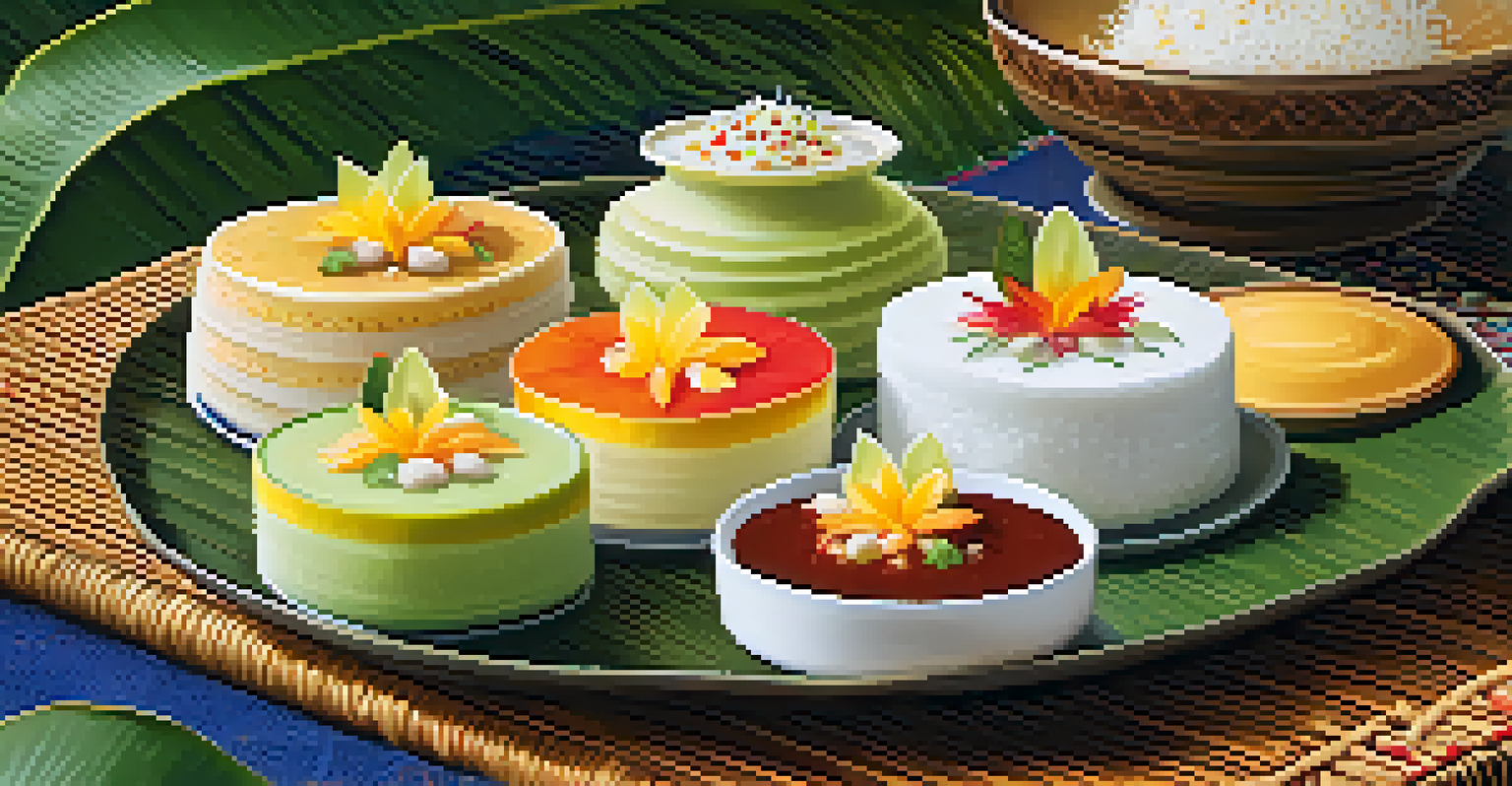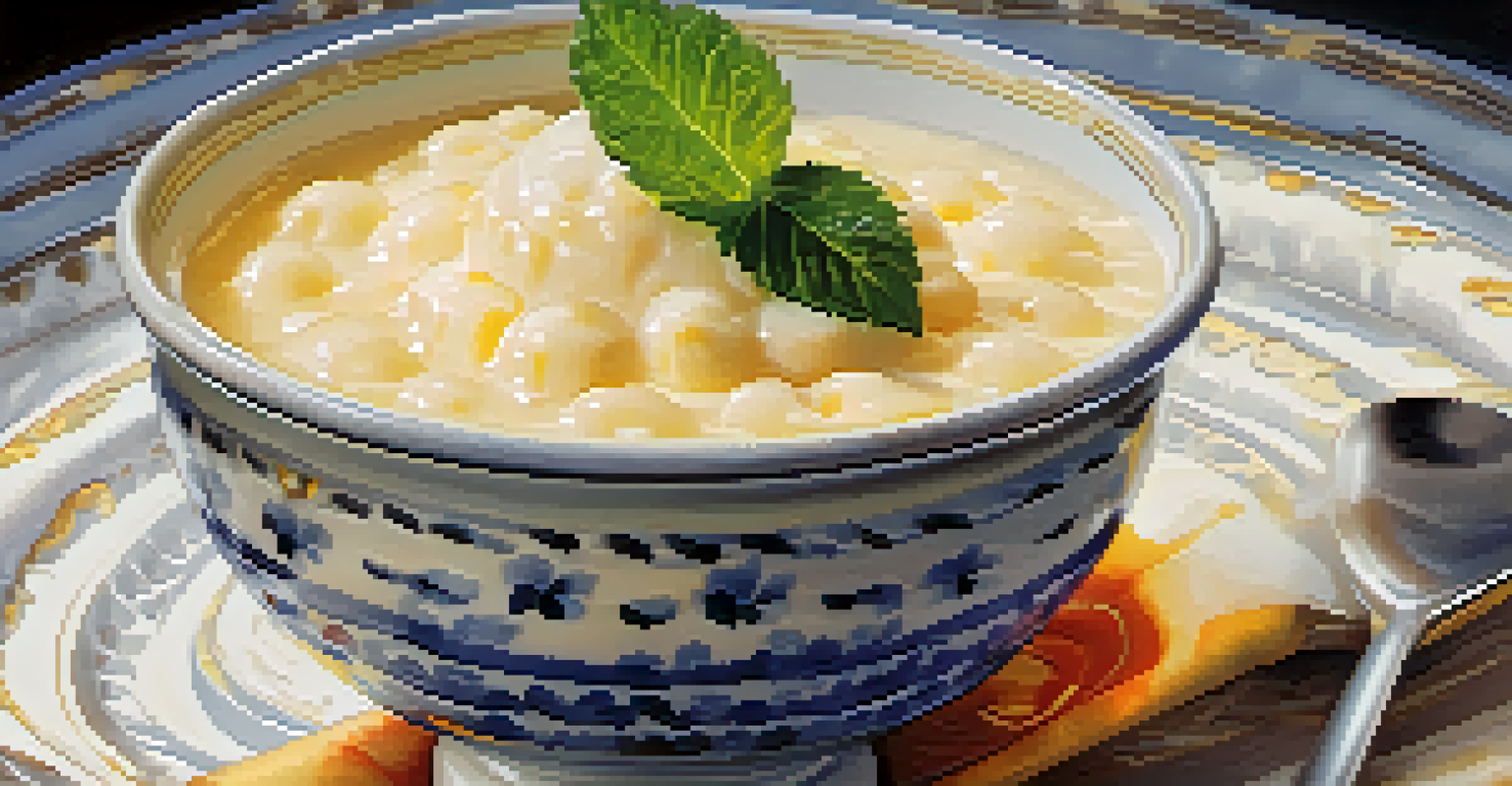Exploring Thai Desserts in Culinary Classes

Introduction to Thai Desserts and Their Cultural Significance
Thai desserts are a vibrant reflection of the country's rich culture and traditions. Often made with coconut, sticky rice, and tropical fruits, these sweets are not just treats; they're a celebration of flavors. Understanding their cultural significance adds depth to the culinary experience, making each dessert a story waiting to be told.
Food is not just about sustenance; it’s about sharing and creating memories together.
In culinary classes, instructors emphasize the importance of these desserts in Thai festivities and rituals. For instance, during Songkran, the Thai New Year, sweets like 'Khanom Tan' are prepared to honor the season. This cultural context enriches the learning experience, bridging the gap between technique and tradition.
As you explore these desserts in class, you're not just cooking; you're immersing yourself in a heritage that values community, family, and joyful celebrations. Each recipe is a window into Thailand's heart, inviting you to taste and understand its history.
Key Ingredients in Thai Desserts: A Closer Look
The magic of Thai desserts lies in their unique ingredients. Common staples include coconut milk, glutinous rice, and a variety of local fruits, each adding a distinct flavor profile. These ingredients are often combined in innovative ways, creating a delightful explosion of tastes and textures.

In culinary classes, you'll learn how to select and prepare these ingredients to achieve authentic flavors. For instance, mastering the use of pandan leaves, known for their fragrant aroma, can elevate your desserts tremendously. Understanding these components helps you appreciate the artistry behind each dish.
Cultural Significance of Thai Desserts
Thai desserts embody the country's rich culture and traditions, often celebrated during festivals and gatherings.
Moreover, many Thai desserts are naturally gluten-free and can be adapted for various dietary needs. This versatility makes them accessible and enjoyable for everyone, whether you're gluten-sensitive or simply looking to try something new.
Popular Thai Desserts to Master in Culinary Classes
In any culinary class focused on Thai desserts, you'll encounter iconic treats like 'Mango Sticky Rice' and 'Thai Coconut Pancakes'. These dishes are not only delicious but also relatively simple to prepare, making them perfect for beginners. With just a few ingredients, you can create a dessert that wows your friends and family.
Desserts are the fairy tales of the kitchen—a happily-ever-after to a meal.
Another favorite is 'Tapioca Pudding with Coconut Cream', which showcases the balance of sweet and salty flavors typical in Thai cuisine. Learning to make this dish teaches you how to layer flavors and textures, a skill that's invaluable in any culinary repertoire. It's a fun and engaging way to delve deeper into the Thai dessert world.
As you practice these recipes, you'll develop confidence in your skills and an appreciation for Thai culinary techniques. Each dessert becomes a canvas for your creativity, allowing you to experiment while staying true to traditional methods.
Techniques for Creating Authentic Thai Desserts
Mastering Thai desserts involves understanding specific techniques that bring out the best in each ingredient. From steaming sticky rice to crafting delicate coconut creams, these methods are essential for authenticity. In culinary classes, you'll observe demonstrations and get hands-on practice to ensure you grasp each technique.
One important technique is the art of layering flavors, which can be observed in desserts like 'Khanom Chan'. This multi-layered dessert relies on careful preparation to achieve its beautiful, vibrant appearance. Learning how to balance sweetness and texture is key to recreating these traditional dishes.
Key Ingredients for Authenticity
Essential ingredients like coconut milk and glutinous rice are vital for creating the authentic flavors of Thai desserts.
Additionally, many classes incorporate tips for presentation, which is a crucial aspect of Thai desserts. The visual appeal of a dish often enhances the overall experience, making it just as enjoyable to look at as it is to eat. These skills prepare you not only to make desserts but to present them beautifully.
Pairing Thai Desserts with Beverages
No culinary exploration of Thai desserts is complete without considering beverage pairings. Thai iced tea, with its rich flavor and creamy texture, complements many sweet dishes beautifully. Understanding how to match your desserts with the right drinks can elevate the overall dining experience.
In classes, you might experiment with different pairings, learning which flavors enhance or contrast with specific desserts. For example, pairing 'Tapioca Pudding' with a refreshing herbal tea can create a delightful balance of sweetness and freshness. This knowledge is not only fun but also practical for hosting gatherings.
Moreover, exploring beverage pairings opens up discussions about Thai culinary traditions and meal customs. It encourages a deeper understanding of how food and drink interact, reinforcing the idea that dining is a holistic experience.
Exploring Regional Variations of Thai Desserts
Thailand’s diverse regions each boast unique dessert variations, influenced by local ingredients and customs. For instance, Northern Thailand is known for its 'Khanom Jeen', a fermented rice noodle dish often enjoyed with sweet sauces. These regional specialties offer a broader perspective on Thai culinary practices.
Culinary classes often highlight these differences, encouraging students to explore beyond the well-known desserts. By understanding regional variations, you gain insight into the cultural richness of Thailand. This exploration can be a fun and educational journey as you discover lesser-known treats.
Sharing Desserts Builds Community
The act of sharing homemade Thai desserts fosters connections and enhances the joy of cooking within communities.
Incorporating regional variations into your repertoire allows you to bring a taste of Thailand to your own kitchen. It's an opportunity to celebrate the diversity of flavors and techniques that make Thai desserts so special.
The Joy of Sharing Thai Desserts with Others
One of the most rewarding aspects of learning to make Thai desserts is the joy of sharing them with friends and family. Thai culture places great importance on community and hospitality, making dessert sharing a cherished tradition. After all, what better way to bond than over delicious, homemade treats?
In culinary classes, you’ll often find a collaborative environment where students work together to create and taste each other's desserts. This camaraderie not only enhances the learning experience but also fosters a sense of community. It’s a reminder that food is more than just sustenance; it’s a way to connect with others.

As you share your creations, you'll witness the delight they bring to others. Whether it’s at a gathering or a simple family dinner, your Thai desserts can spark conversations and create fond memories. This aspect of cooking adds an emotional layer to your culinary journey, making it even more fulfilling.